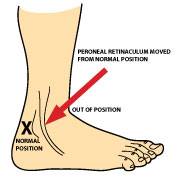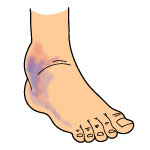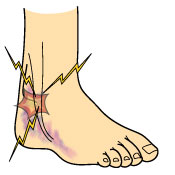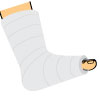What is Peroneal Tendon Subluxation?
The Peroneal Tendons connect the Peroneal Muscles in your lower leg to bones in your ankle and foot. The Peroneal Tendons are contained in a tunnel that is made of fibrous tissue known as the Peroneal Retinaculum. The purpose of the Peroneal Retinaculum is to help keep the Peroneal Tendons in place. If your Peroneal Retinaculum becomes damaged, this could cause Peroneal Tendon Subluxation, which involves the Peroneal Tendons moving out of their normal position.
If your Peroneal Tendons cannot relocate (go back to their normal position), this means you don’t have Peroneal Tendon Subluxation, but Peroneal Tendon Dislocation.
 Causes
Causes
If the Peroneal Retinaculum becomes injured or is torn, the Peroneal Tendons can slip out of place and over your lateral malleolus (the bony bump on the outside of your ankle).
The most common cause of Peroneal Tendon Subluxation is an ankle sprain. This is often seen in activities like football, volleyball and basketball.
Signs & Symptoms
Most people with Peroneal Tendon Subluxation experience a snapping sensation along the outside of the ankle at the time of injury. The tendon is often felt moving in and out of po sition after injury. There will also be a decreased ability to bear weight on the affected ankle. Other signs and symptoms include:
sition after injury. There will also be a decreased ability to bear weight on the affected ankle. Other signs and symptoms include:
- Pain
- Swelling
- Bruising
- Tenderness
Treatments
Surgery for Peroneal Tendon Subluxation is almost always required. However, there are some non-surgical treatment options that may help manage your symptoms:
Applying tape over the Peroneal Tendons will help keep them in place, which will in turn decrease your symptoms. Tape also adds compression, which works to bring down swelling.
Physiotherapy
Physical therapy can help restore mobility and strength to your injured ankle. This can include stretching exercises, strengthening exercises, bracing, cold compression, heat, massage, and other treatment modalities.
NSAIDs
Non-steroidal anti-inflammatory medications like Advil (ibuprofen) and Aleve (naproxen) can help to alleviate your pain and swelling.
In more mild cases of Peroneal Tendon Subluxation, your ankle may be placed in a cast or boot for 4-6 weeks to prevent movement. This is designed to help the injury heal faster.
Surgery
There are several different surgical options when it comes to Peroneal Tendon Subluxation. Your doctor will recommend the correct surgery for you based on the severity of your injury. In many cases, a repair of the Peroneal Retinaculum is recommended. If it is identified at the time of surgery that you do not have a Peroneal Groove, one will be created. The Peroneal Groove is located at the back of the calf bone and helps the Peroneal Tendons move properly, although some people do not have one. Not having a Peroneal Groove can contribute to the development of Peroneal Tendon Subluxation.
Following surgery, you will be instructed to stay off the affected ankle for 4-6 weeks. You will wear a splint or cast during this time and use crutches to get around. Physical therapy is recommended once the splint or cast is removed.

